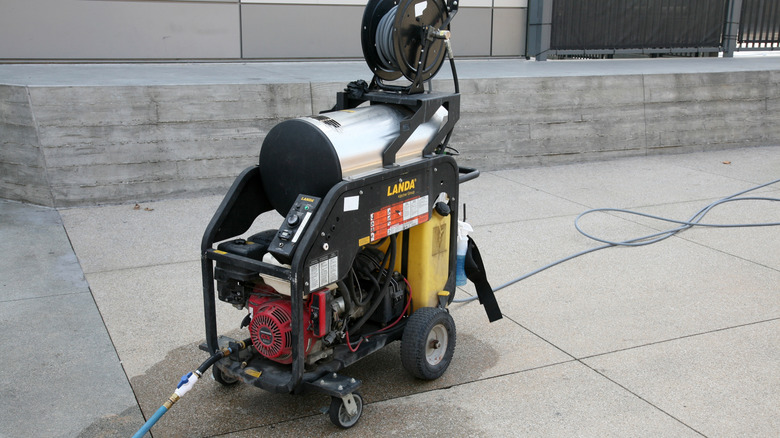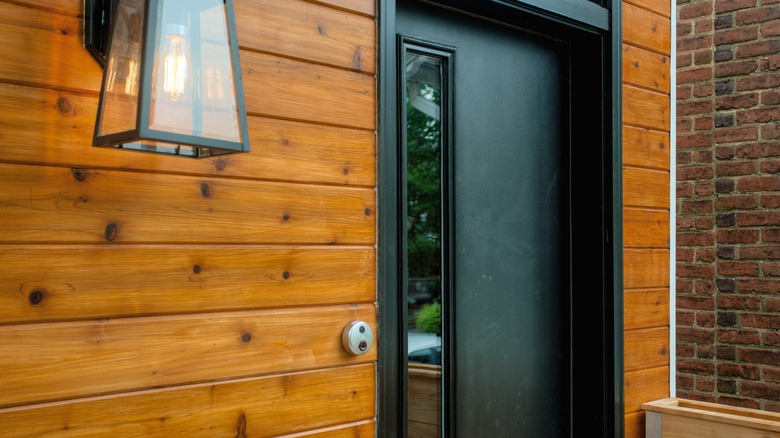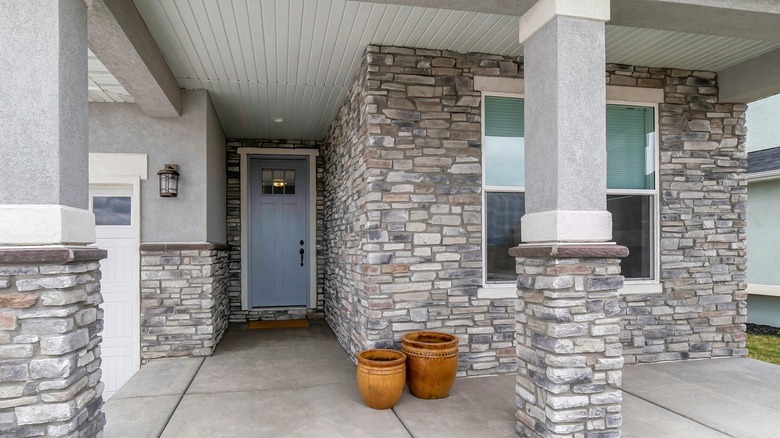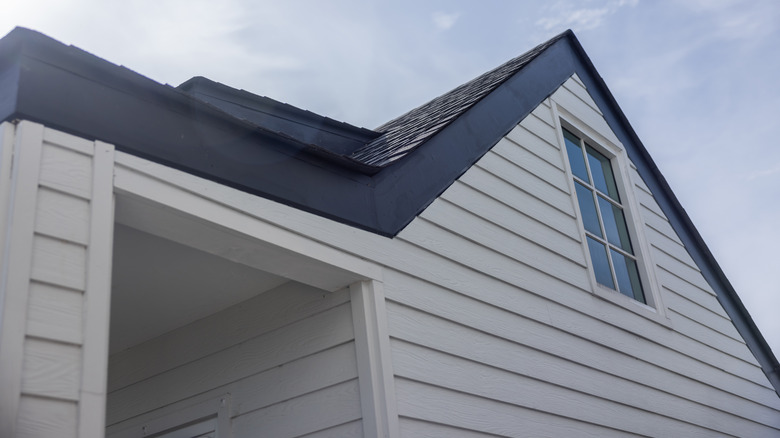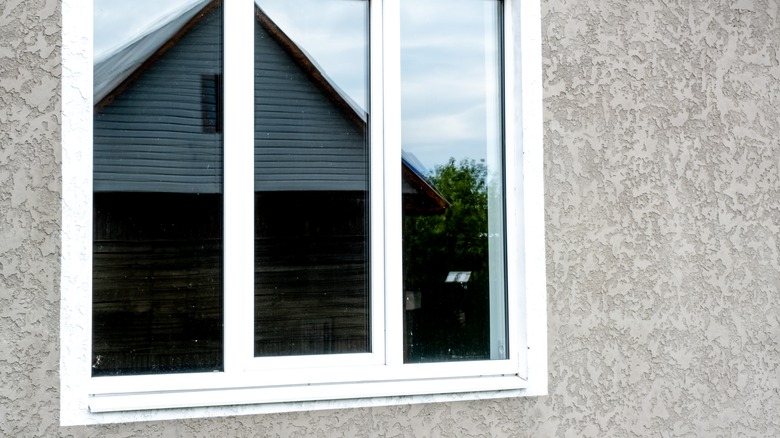Common Types Of House Siding You Should Never Clean With A Pressure Washer
A common exterior that numerous houses have is siding. To clean this section, many people use a power washer. While popular, there are some siding materials that can't handle this cleaning pressure, such as wood, stone veneer, fiber cement, and stucco. Just because you shouldn't use this tool doesn't mean that you shouldn't clean your siding. The best way to sanitize is with soft washing. This is a cleaning approach that involves using low water pressure and cleaning solutions to wipe away lingering dirt and bacteria. To soft wash a house, you need to gather a solution sprayer, various nozzles, goggles, a mask, gloves, and extension poles. For the cleaning solution, mix water, bleach, and surfactant, a product that helps loosen up dirt, debris, and other stuck gunk.
Start by moving outdoor furniture and covering any shrubs, flower beds, and gardens. Follow the instructions for the solution product you choose and mix it together. Spray it on your home's siding, letting it sit for up to 10 minutes. Rinse off the cleaning product from top to bottom to avoid streaks. Repeat the process for any lingering stains. This method helps wash hard-to-reach places, avoids destruction to the outside of your home, allows a longer-lasting clean, and avoids safety hazards. Soft cleaning is not for everyone, especially in those exceptionally high spots; instead, contact a professional team to help.
Wood siding
Made of various trees like pine, redwood, fir, or cedar, wood siding is not for individuals who don't plan on regularly maintaining their home's exterior. Before installing wood siding on your house, you must remember that it needs proper and strict upkeep. If left to its own devices, it can rot and warp due to high exposure to moisture. And if you do decide to clean it, using a pressure washer can incur other costly damages, especially if set on a higher spray level. Too much water pressure can also cause water to spurt under the wood siding, creating mold and mildew problems as well as possible issues with insulation and electrical fixtures.
While you can soft wash this exterior on your own, power washing it is best left to the professionals to ensure that you don't accidentally damage your own property since wood can be so finicky. There are also preventative measures you can take to help defend your wood siding from the weather and other outdoor elements, including applying a stain and clear sealant or re-painting it every now and again. If you notice cracking, make sure to seal the area right away. You also can trim plants back to keep moisture at bay. While it is an eco-friendly option, you'll need to regularly inspect your wood siding if you want it to last you years.
Stone veneer siding
As a durable and affordable option, there are many homes with stone veneer siding and other decorative accents. Made of cement, natural aggregates, and iron oxide pigment, this veneer is a great back up option to brick or real stone. While stone veneer doesn't need to be cleaned very often, that doesn't mean you shouldn't clean it at all. Due to stone veneer being installed with panels, it can leave tiny cracks for moisture to get trapped, leading to mold and mildew growth. However, this exterior covering doesn't do well with the high pressure produced by a power washer. Also, steer away from bleach solutions or acid-based cleaners; instead, use mild dishwashing soap.
In most cases, you can easily keep this siding option clean by giving it a thorough rinse down with a hose in between deep cleans. If you decide on detergent, wet the stone first and dunk your sponge or rag into the cleaning solution. Scrub the section to remove dirt, grime, and bacteria. Rinse and repeat. You can follow this same technique for your indoor stone veneer pieces; you'll just also need to use a vacuum to remove dust and dirt as well as a bucket and rags instead of a hose. If you live in an area with extreme weather, you also can place a sealant on the exterior of your siding. Remember to follow whatever instructions are on the product you choose. For hard-to-reach spots, call a professional team for cleaning and sealing.
Fiber cement siding
Many contractors suggest installing fiber cement siding on exteriors because of its durability, weather resistance, and versatility. While you can try pressure washing this material, you must use the proper technique or expect to incur costly damages on this siding made of sand, cement, cellulose fibers, and water. Skip that unnecessary headache and pressure by going with the safest option from the beginning — soft washing. With fiber cement boarding, protect it from damage by using a mild detergent, a hose, and a scrub brush with gentle bristles in between soft washing sessions. You'll also want to check the caulking around the windows while cleaning your siding to prevent moisture from getting inside.
While this is a low-maintenance siding option, you still need to regularly clean, repair, and inspect it. If your exterior experiences cracks or dents, there are patch kits you can purchase to fix the area. Once seams are exposed, you'll need to reseal your fiber cement siding for extra protection once again. But don't worry, a good hose down twice a year should do the trick most of the time. With the right care, you can expect your fiber cement siding to last you decades.
Stucco siding
Since it is a mixture of sand and cement, stucco has a tendency to crumble under high pressure and must be treated delicately. In many cases, you'll be cleaning a rough-textured stucco siding a bit more often since the texture shows off dirt and grime more prominently than a smoother finish. This type of siding will only last you years if you properly keep up with its maintenance. As it's prone to hairline cracks, you'll need to keep a bottle of caulk on hand to fill in these spots before you even start cleaning. For cracks in hard-to-reach spots or on the second story, contact a professional team for assistance.
Once sealed, rinse your siding to remove any loose dirt or debris and then apply the detergent mixture of your choice. It will need to sit for up to 10 minutes to properly target mold and mildew. While you may want to use a DIY vinegar solution, it can accidentally remove efflorescence, that fine crystallized white powder found on plaster. Instead, stick to detergent cleaners and scrub the area with a gentle brush. Rinse with a hose and repeat until all the dirt is gone. Most stains will come off with dish soap and water, while a bleach mixture will remove mold and mildew.
